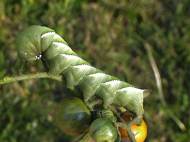Gut movements in caterpillars have impact on robotic design
 Weird movements in the abdomens of freely crawling caterpillars are making headlines in the fields of biology and engineering. The findings from a multidisciplinary team of researchers, including Jake Socha, Virginia Tech assistant professor of engineering science and mechanics, Michael Simon of Tufts University’s Department of Biology, and Barry Trimmer, professor of biology at Tufts, could inspire the development of a soft-bodied robot.
Weird movements in the abdomens of freely crawling caterpillars are making headlines in the fields of biology and engineering. The findings from a multidisciplinary team of researchers, including Jake Socha, Virginia Tech assistant professor of engineering science and mechanics, Michael Simon of Tufts University’s Department of Biology, and Barry Trimmer, professor of biology at Tufts, could inspire the development of a soft-bodied robot.
The researchers used a type of powerful X-ray imaging in order to discover internal soft-tissue movements that were massively out of sync with the external body movements (the X-rays were used because large caterpillars are entirely opaque). Afterwards, they verified these findings by using transmission-light microscopy to see the internal soft-tissue movements of smaller, translucent caterpillars as they slowly inched their way along a glass microscope slide.
This combined imaging showed that the caterpillar’s gut slid forward in advance of the surrounding tissues. The novelty is that the caterpillar’s center of mass moves forward while the middle “legs” are anchored to the substrate. The internal gut movements are locally decoupled from visible translations of the body.
This movement meant the abdomen typically advanced an entire step forward before the body wall caught up. The researchers described their findings as “a unique phenomenon of gut sliding”. For more information about their research read the paper that will be featured in the upcoming issue of Current Biology: “Visceral-Locomotory Pistoning in Crawling Caterpillars”.
Since the research team is also interested in engineering applications, they moved from considering the biological implications of their findings to potential uses in soft-bodied robots. The potential these robots have is large, due to their shape-shifting ability. These shape-shifting robots could be used in search-and-rescue operations, medical applications and space research applications. Let’s see if they’ll come up with something more advanced than Chem-bot – iRobot’s shape-shifting blob robot we described in one of our previous articles.









Leave your response!